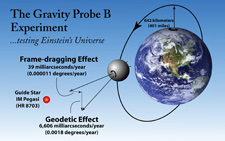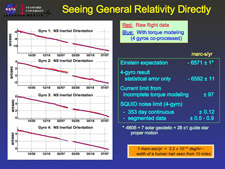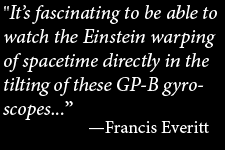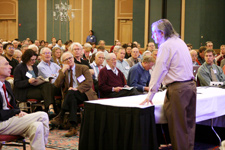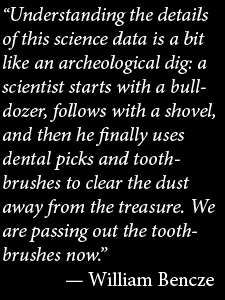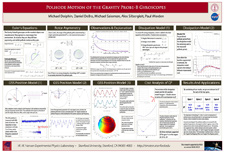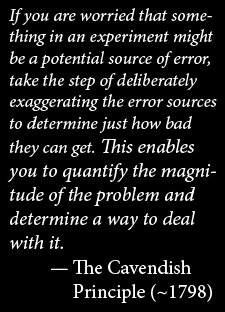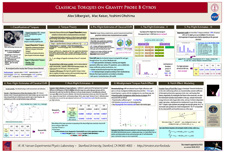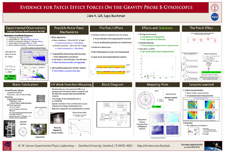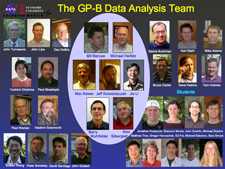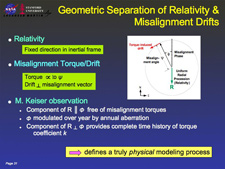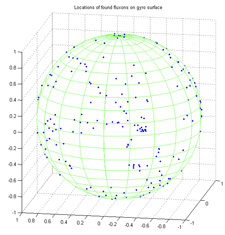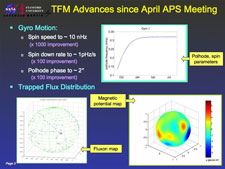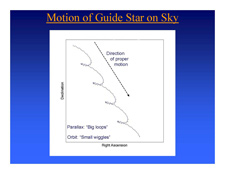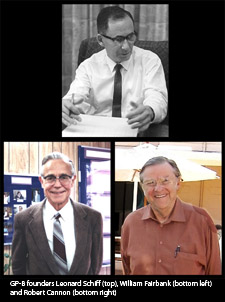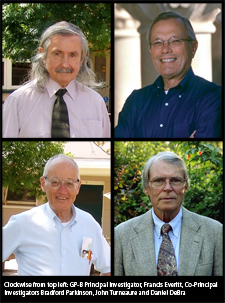Summer 2007
GP-B SUCCEEDED IN COLLECTING THE DATA TO TEST EINSTEIN'S PREDICTIONS ABOUT GRAVITY
Over four decades of planning, inventing, designing, developing, testing, training and rehearsing paid off handsomely for GP-B. The 17.3-month flight mission succeeded in collecting all the data needed to carry out this unprecedented, direct experimental test of Einstein's general theory of relativity—his theory of gravity.
GP-B is arguably the most sophisticated spacecraft ever flown. It incorporated many new technologies—most notably the gyros, their suspension systems, the accompanying SQUID readouts, and the precision-pointing of the spacecraft-fixed telescope—all of whose debut performances in space occurred during this mission. It is remarkable, and a testament to the preparation, talent, knowledge and skill of the Stanford-NASA-Lockheed Martin development team, that all of these technologies performed exceedingly well on orbit, with some, such as the Gyro Suspension System and SQUID readouts, significantly exceeding their required performance specifications.
As Gaylord Green, the GP-B Program Manager during launch operations, remarked after the spacecraft was in orbit and all systems were functioning nominally: "...10,000 things went right!"
- Click Here to view a 2-page overview of GP-B in a nutshell
- Click Here to view a 28-page summary of the GP-B program, including its history, experimental design, technology, mission and legacy
THE EFFECTS OF GENERAL RELATIVITY ARE CLEARLY VISIBLE
The GP-B satellite was designed as a pristine, space-borne laboratory, whose primary task was to use four ultra-precise gyroscopes to measure directly two effects predicted by general relativity. One is the geodetic effect—the amount by which the mass of the Earth warps the local space-time in which it resides. The second effect, called frame-dragging, is the amount by which the rotating Earth drags local space-time around with it. Because the spacecraft is in a polar orbit, the two effects occur at right angles to each other, giving a clean separation between them. Furthermore, the gyros are arranged such that each measures both effects.
According to Einstein’s theory, over the course of a year, the geodetic warping of Earth's local space-time should cause the spin axis of each gyroscope to shift from its initial alignment by a minuscule angle of 6.606 arc-seconds (0.0018 degrees) in the plane of the spacecraft’s orbit. Likewise, the twisting of Earth’s local space-time should cause the spin axis to shift by an even smaller angle of 0.039 arc-seconds (0.000011 degrees)—about the width of a human hair viewed from a quarter mile away—in the plane of the Earth’s equator.
In the accompanying graph to the right, the geodetic effect is clearly visible in the unprocessed data from the GP-B gyroscopes, confirming Einstein's predictions to a precision of better than 1 percent. As Professor Francis Everitt, GP-B Principal Investigator, recently remarked: "It’s fascinating to be able to watch the Einstein warping of spacetime directly in the tilting of these GP-B gyroscopes—more than a million times better than the best inertial navigation gyroscopes."
We have also seen indications of the frame-dragging effect, which is 170 times smaller than the geodetic effect. GP-B scientists are still in the process of extracting its signature from the spacecraft data.
FIRST PEEK AT RESULTS PRESENTED AT APRIL APS MEETING; FINAL RESULTS IN DECEMBER
After 18 months of rigorous, ground-breaking data analysis, our science team presented the first public peek at the results summarized above during the April meeting of the American Physical Society (APS) in Jacksonville, Florida. Professor Francis Everitt kicked off the April APS meeting with a plenary talk entitled: Gravity Probe B Interim Report and First Results. In addition, various GP-B team members gave three invited talks, two submitted papers and presented 22 poster papers on various aspects of GP-B.
The preliminary results we announced at the April APS meeting for the geodetic effect are consistent with the prediction of general relativity to an accuracy of ~1.0 percent. This is on par with the only other measurement of this effect that was performed using the Earth-Moon system orbiting the Sun, but seen in a different and much more direct way. Moreover, the indications of frame-dragging measured thus far are also highly encouraging. However, for both measurements, the current level of experimental error must be significantly reduced and the measurements thoroughly cross-checked before being announced as final results.
The inherent noise in the GP-B SQUID readout system imposes a natural physical limitation on the experimental accuracy that it is possible to achieve with the GP-B instrument. For the geodetic effect, this limit is ~0.01 percent, and for the much smaller frame-dragging effect, the limit is ~1.0 percent. The goal of GP-B is to achieve the highest possible experimental accuracy, approaching the physical limitations of the instrument readout.
The GP-B science instrument has sufficient resolution and we have collected ample data to obtain results approaching these limits. However, early in the data analysis, our science team uncovered surprising torque and sensor effects (from polhode motion of the gyros) that must separated and removed from the relativity effects in order to obtain the desired level of accuracy. Addressing these torque and sensor effects has been our science team's dominant focus in recent months, and this has led to a longer and more sophisticated data analysis process than was originally anticipated.
Three weeks prior to the APS meeting, our GP-B science team reviewed the progress with the independent GP-B Science Advisory Committee (SAC) that has been consulting with us on every aspect of the program for the past decade. Summarizing the committee's findings and recommendations, SAC Chairman, Professor Clifford Will of Washington University in St. Louis, MO. and author of the classic text, Theory & Experiment in Gravitational Physics, reported: "The GP-B science team is continuing to make good progress on a number of fronts... We strongly support the [Stanford] proposal for funding through December 2007 to complete the data analysis and prepare publication of the final GP-B result." NASA has committed to extending support for GP-B at the required level.
At the APS meeting, GP-B Program Manager, William Bencze, summarized the situation: "Understanding the details of this science data is a bit like an archeological dig: a scientist starts with a bulldozer, follows with a shovel, and then he finally uses dental picks and toothbrushes to clear the dust away from the treasure. We are passing out the toothbrushes now."
- Click Here to view details about the GP-B presentations at the April APS meeting, including PDF presentation slides and corresponding MP3 audio recordings of all the talks and reduced-size PDF copies of all the posters.
THE TWO SURPRISES & THEIR IMPACT ON THE EXPERIMENT
Francis Everitt is fond of telling the story that in the months leading up to the GP-B launch, several people who had deep experience with other space missions told him that all the things he knew were likely to go wrong would work perfectly, but other things that couldn't possibly cause any difficulty would keep the team up at night.
These turned out to be prophetic words. Our science team made two significant discoveries about the science instrument that have lengthened the data analysis process:
-
Shortly after the gyros were spun up in August 2004, we discovered that the polhode motion of the gyro rotors, which was expected to exhibit a constant pattern throughout the experimental period, was changing over time, significantly complicating the calibration of the gyroscope readout angles.
-
During the post-experiment instrument calibration testing in August-September 2005, the spin axes of the gyroscopes were found to be affected by certain class of small classical torques, known as “misalignment torques,” whose effects must be rigorously separated from the relativity measurements
However, the team was prepared for such an eventuality. In fact, the GP-B experiment was carefully designed to enable us to discover such unexpected sources of error. As Francis Everitt notes: "When trying to do an experiment that goes seven orders of magnitude beyond where anyone has gone before, some extraordinary planning is necessary. First, you design the experiment to make all the errors as close to zero as possible. Next, you average everything you can—for example, you roll the spacecraft throughout the experiment. Finally, you purposely look for things that were not expected."
During one of many NASA program reviews prior to launch, experienced investigators from other NASA missions asked us what processes we had put in place to discover systematic sources of error that might crop up in the data. Our answer was that we would follow a principle set forth by the 18th century scientist, Henry Cavendish—namely, if you are worried that something in an experiment might be a potential source of error, you take the step of deliberately exaggerating the error sources to determine how bad they can get. This process enables you to quantify the magnitude of the problem and determine a way to deal with it.
From mid-August through September 2005, after collecting 50 weeks of science data and before the liquid helium was exhausted from the dewar, we followed Cavendish's principle by performing a barrage of calibration tests on all parts of our science instrument. These tests, along with other tests that we performed throughout the mission, enabled us to confirm that all of the known and expected sources of error—with one exception—were, in fact, negligible as expected. As William Bencze put it: "Without the extensive calibration tests, we would have been looking for a needle in a haystack; instead, we only had to look for a needle on the floor."
Specifically, these tests confirmed that six of the seven extrinsic "near zero" design specifications of the experiment had been met or exceeded, and we were able to eliminate each of these factors as sources of error in the final results. The exception that we could not eliminate as a source of error was the seventh extrinsic design constraint that the electric dipole moment of the gyro rotors be "near zero." In other words, the gyro rotors must be highly electrically spherical as well as mechanically spherical.
The electrical out-of-roundness is due to larger than anticipated electrostatic patches (regions of electrical charge) on the rotor’s surface. These patches interact with similar ones on the housing’s inner surface to give rise to small “misalignment torques” that occur when the spin axes of the gyros are not aligned with the roll axis of the spacecraft. These patches also provide a subtle damping mechanism that extracts small amounts of energy from the spinning rotor, and this causes the polhode path to change. The potential existence of these patches was known prior to launch, but was believed to be negligible, based on careful physical analysis and laboratory measurements.
Nature is full of surprises, and it is common for physics experiments, particularly a ground-breaking experiment such as GP-B, to uncover unexpected phenomena. Because we anticipated this situation and were actively looking for surprises in the data, we were prepared to deal with them. Consequently, the team has been able to model precisely the polhode motion of all four gyroscopes, as well as the classical torques imparted by patch effects on the rotors and housings. This painstaking work, which is still in progress, has lengthened the data analysis phase of the mission by more than a year—such is the nature of scientific inquiry. Ultimately, the time spent isolating and removing these confounding effects from the final results will reduce the current margin of experimental error to the desired level.
Our goal in GP-B has always been to perform the best possible experiment and to use great care and redundancy to ensure the validity of the results. Every experiment has its share of unknowns or challenges that no one could have anticipated. But once such challenges surface, it is incumbent on the investigators to spend time addressing them and accounting for them in the process of determining the final outcome.
- Click Here to view a PDF copy of Professor Francis Everitt's 1977 paper entitled: Gravitation, Relativity and Precise Experimentation, which describes Henry Cavendish's torsion balance experiments to determine the value of the gravitational constant, G, as well as other high-precision experiments.
- Click Here to read a more detailed description of the GP-B gyro polhode motion, misalignment torques, and patch effects.
NEXT STEPS—MOVING TOWARDS A FINAL RESULT
Our GP-B data analysis team comprises 34 people, including Principal Investigator, Francis Everitt. Program Manager, William Bencze, manages the team, and Chief Scientist, Mac Keiser, is ultimately responsible for the data analysis and results. The remainder of the team includes 22 scientists (physicists, mathematicians, engineers, and computer scientists), plus 9 physics and engineering graduate students. The entire data analysis team, except for Francis Everitt, is pictured to the right.
Last summer (2006), Mac Keiser devised a model-based, geometric method for separating the disturbance (misalignment) torques from the relativity signals. Over the past year, the team has been pursuing a combination of this geometric method and a model-based, algebraic estimation method formulated by mathematician Michael Heifetz. Recently, physicist Alex Silbergleit, following a line of inquiry first suggested by physicist Jeff Kolodziejczak (a collaborator from NASA's Marshall Space Flight Center), has found a way to combine the advantages of both the geometric and algebraic methods into a unified, integral data analysis approach. This integral approach eliminates the drawbacks of both previous methods, allows for iterative improvement of the results, and relies less on modeling than either of the previous methods. Thus, we will be continuing to employ this integral approach through the end of the analysis.
Specifically, our science team is focusing on two main issues:
- Fine calibration of the gyroscope/telescope scale factor
Both the SQUID-based magnetic measurement of the gyro spin axes and the telescope measurement of the spacecraft pointing direction with respect to the guide star produce electrical signals that represent angular measurements. Because these two systems are independent of each other, it is necessary to cross-calibrate these instruments to ensure that both systems are measuring the same relative angle when the orientation of the spacecraft changes.
Because of trapped magnetic flux on the gyro rotors, the calibration—conversion from electrical signals to angles—of the gyro readout can vary in a complex, but computable way. Specifically, it is affected by the polhode period of the gyros, which was found to change during the flight mission, rather than remaining constant as originally expected.
To address these issues and determine the correct scale factor, the team is in the process of precisely modeling the time-varying polhode periods of each gyro for each orbit as well as creating precise mappings of the trapped magnetic flux on the surface of each gyro rotor.
- Refining the analysis of the misalignment torques
The team is in the process of refining the data analysis techniques being used to separate and remove these classical misalignment torques from the relativity effects. To do this, it is necessary to take into account many variables, including vehicle motion and polhode paths of the gyros.
The refinement of the misalignment torques and the mapping of the trapped magnetic flux on the gyro rotors interact such that if one is incorrect, the other becomes harder. There is also a symbiotic relationship between these two activities so that as one improves, it facilitates calculating the other.
In addition to these two activities, the GP-B guide star (IM Pegasi) proper motion data is being held by Irwin Shapiro and his group at the Harvard Smithsonian Center for Astrophysics (CfA). Upon completion of the data analysis endeavor here at Stanford, this extremely precise VLBI measurement data will be substituted for the current placeholder values for the proper motion of IM Pegasi, taken from the 1997 Hipparcos [star] Catalogue, in order to obtain the greatest possible accuracy in the final GP-B result.
- Click Here to view our APS Meeting page, where you can download an audio recording and PDF slides from Irwin Shapiro's APS paper, plus two poster papers on the GP-B Guide Star Astrometry Project at the CfA.
GP-B DATA ARCHIVE TO BE AVAILABLE THROUGH NSSDC IN JULY
During the past few weeks, while our science team continues to analyze the data, our GP-B data processing team has also been quite busy, compiling an archive of the GP-B raw data—both science data and spacecraft/payload status data, as well as an archive of associated documents, drawings, photos and other information about the GP-B mission. We are currently in the process of transferring this entire archive to the National Space Science Data Center (NSSDC), located at the NASA Goddard Space Flight Center in Greenbelt, Maryland. Transfer of this archive will be completed in late June, and the GP-B archive will then become publicly available sometime thereafter.
ASTRONOMER SPOSETTI NAMES 3 MINOR PLANETS HONORING GP-B PRINCIPALS
Swiss physics teacher and amateur astronomer Stefano Sposetti, along with his colleagues and pupils, has been following GP-B with great interest for a number of years. In August 2004, he photographed the GP-B spacecraft in orbit through his telescope as it passed through the constellation Pegasus, the location of our GP-B guide star, IM Pegasi (see our Mission Update of 13 August 2004.)
Recently, Mr. Sposetti sent us an email message noting that last year he sent proposals to the Minor Planet Center (MPC) for naming three minor planets he had discovered in 2000 to honor some of the people involved in the GP-B experiment. The MPC has officially accepted his proposals and now three GP-B principals--Leonard Schiff, Francis Everitt, and William Fairbank--have joined the long list of minor planet names.
- Click Here to read more about the three minor planets that Mr. Sposetti discovered and view simulations of their orbits..
We very much appreciate Mr. Sposetti's long-standing interest in GP-B and we are grateful to him for sending us this information.
A BRIEF OVERVIEW OF GRAVITY PROBE B
The idea of testing general relativity with orbiting gyroscopes was suggested independently by two physicists, George Pugh and Leonard Schiff, in late 1959-early 1960. Schiff, then chairman of the Stanford University Physics Department, published a paper summarizing the experiment, Possible New Experimental Test of General Relativity, in Physical Review Letters (March 1960). Also during this time, Schiff teamed up with two colleagues from the Stanford faculty: low-temperature physicist William Fairbank and gyroscope expert Robert Cannon of the Department of Aeronautics & Astronautics. Thus was born the collaboration between the Stanford Physics and Engineering departments that has been essential to the success of Gravity Probe B.
In 1962, Francis Everitt was invited to Stanford as the first full-time academic staff member on the experiment. NASA’s Office of Space Sciences, under the leadership of Dr. Nancy Roman, provided research funding in 1964, with Fairbank and Cannon as Co-Principal Investigators and Schiff as Program Advisor. In 1971, program management was transferred to NASA’s Marshall Space Flight Center (MSFC) in Huntsville, AL.
GP-B is the longest running, continuous physics research program at both Stanford and NASA. While the experiment is simple in concept—it utilizes a star, a telescope and a spinning spherical gyroscope—it took more than four decades to design and produce all the cutting-edge technologies necessary to bring the GP-B satellite to the launch pad, carry out this experiment and analyze the data.
- Click Here to view a 2-page overview of GP-B in a nutshell
-
Click Here to view a 28-page summary of the GP-B program, including its history, experimental design, technology, mission and legacy
NEXT MISSION UPDATE—END OF AUGUST
Our next regularly scheduled mission update will be towards the end of August. Of course, we will post a timely update if noteworthy events occur here at GP-B in the meantime.
LINKS TO OTHER GP-B TOPICS
- GP-B Frequently Asked Questions (FAQ)
- Track the satellite in the sky
- Photo, video & and news links
- Build a paper model of the GP-B Spacecraft
- Following the mission online
- Our mailing list—receive monthly status updates via email
- Download an MPEG4 streaming video of Professor Everitt's 18 May 2006 lecture on GP-B
Both audio-only and video versions of this lecture are also available on the Stanford on iTUNES U Web site. This Web page automatically launches the Apple iTunes program on both Macintosh and Windows computers, with a special Stanford on iTunes U "music store," containing free downloads of Stanford lectures, performances, and events. Francis Everitt's "Testing Einstein in Space" lecture is located in the Faculty Lectures section. People with audio-only iPods can download the version under the Audio tab; people with 5th generation (video) iPods can download the version under the Video tab.
Previous Update
Index of Updates




